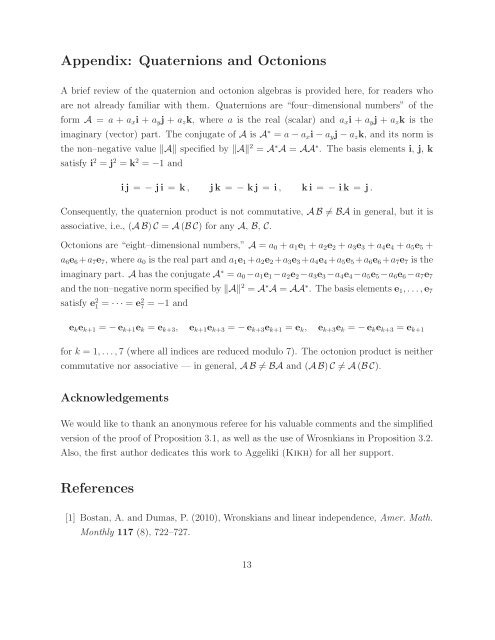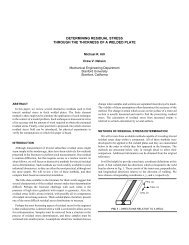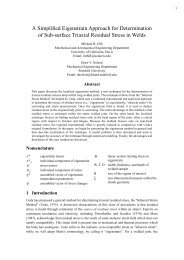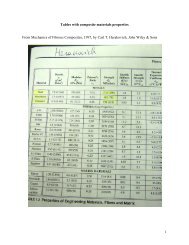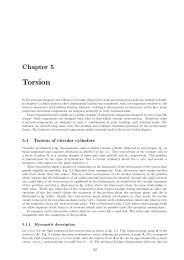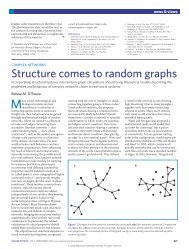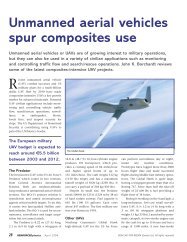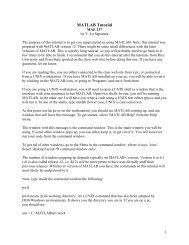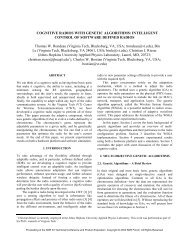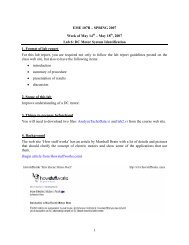Pythagorean-hodograph curves in Euclidean spaces of dimension ...
Pythagorean-hodograph curves in Euclidean spaces of dimension ...
Pythagorean-hodograph curves in Euclidean spaces of dimension ...
You also want an ePaper? Increase the reach of your titles
YUMPU automatically turns print PDFs into web optimized ePapers that Google loves.
Appendix: Quaternions and Octonions<br />
A brief review <strong>of</strong> the quaternion and octonion algebras is provided here, for readers who<br />
are not already familiar with them. Quaternions are “four–<strong>dimension</strong>al numbers” <strong>of</strong> the<br />
form A = a + axi + ayj + azk, where a is the real (scalar) and axi + ayj + azk is the<br />
imag<strong>in</strong>ary (vector) part. The conjugate <strong>of</strong> A is A ∗ = a − axi − ayj − azk, and its norm is<br />
the non–negative value A specified by A 2 = A ∗ A = AA ∗ . The basis elements i, j, k<br />
satisfy i 2 = j 2 = k 2 = −1 and<br />
ij = − ji = k , jk = − kj = i , ki = − ik = j .<br />
Consequently, the quaternion product is not commutative, A B = BA <strong>in</strong> general, but it is<br />
associative, i.e., (A B) C = A (B C) for any A, B, C.<br />
Octonions are “eight–<strong>dimension</strong>al numbers,” A = a0 + a1e1 + a2e2 + a3e3 + a4e4 + a5e5 +<br />
a6e6+a7e7, where a0 is the real part and a1e1+a2e2+a3e3+a4e4+a5e5+a6e6+a7e7 is the<br />
imag<strong>in</strong>ary part. A has the conjugate A ∗ = a0 −a1e1 −a2e2 −a3e3 −a4e4 −a5e5 −a6e6 −a7e7<br />
and the non–negative norm specified by A 2 = A ∗ A = AA ∗ . The basis elements e1, . . .,e7<br />
satisfy e2 1 = · · · = e2 7 = −1 and<br />
ekek+1 = −ek+1ek = ek+3, ek+1ek+3 = −ek+3ek+1 = ek, ek+3ek = −ekek+3 = ek+1<br />
for k = 1, . . .,7 (where all <strong>in</strong>dices are reduced modulo 7). The octonion product is neither<br />
commutative nor associative — <strong>in</strong> general, A B = BA and (A B) C = A (B C).<br />
Acknowledgements<br />
We would like to thank an anonymous referee for his valuable comments and the simplified<br />
version <strong>of</strong> the pro<strong>of</strong> <strong>of</strong> Proposition 3.1, as well as the use <strong>of</strong> Wrosnkians <strong>in</strong> Proposition 3.2.<br />
Also, the first author dedicates this work to Aggeliki (Kikh) for all her support.<br />
References<br />
[1] Bostan, A. and Dumas, P. (2010), Wronskians and l<strong>in</strong>ear <strong>in</strong>dependence, Amer. Math.<br />
Monthly 117 (8), 722–727.<br />
13


